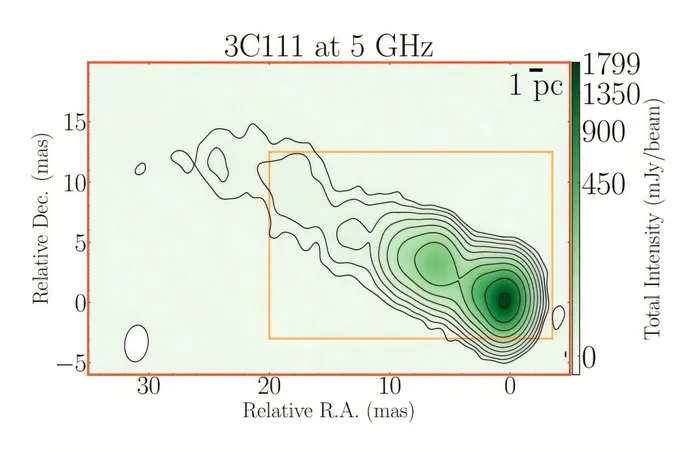
Unveiling the Mysteries of Radio Galaxy 3C 111 and Its Intriguing Jet: A Deep Dive into Astronomical Observations
2025-04-01
Author: Arjun
Introduction
In a groundbreaking study utilizing the Very Long Baseline Array (VLBA), European astronomers have illuminated the enigmatic radio galaxy known as 3C 111 through a series of multi-wavelength observations. Published on March 24 on the arXiv preprint server, this research offers new insights into the characteristics of this galaxy and its dynamic relativistic jet, providing fresh data that could reshape our understanding of cosmic phenomena.
Understanding Radio Galaxies
Radio galaxies (RGs) are fascinating celestial entities that emit tremendous amounts of radio waves from their active cores. At the heart of these galaxies lie supermassive black holes, which siphon in nearby gas and dust. This process fuels high-energy jets that can accelerate charged particles to incredible velocities, making them visible in radio wavelengths.
Astrophysicists categorize radio galaxies into two main classes based on their morphology and radio luminosity: Fanaroff-Riley Type I (FR I) and Type II (FR II). FR I galaxies exhibit lower energy outputs, with jet-dominated emissions. In contrast, FR II galaxies like 3C 111 are characterized by their high power and extensive hot spots—regions where jets collide with the intergalactic medium, resulting in dramatic emissions.
Characteristics of 3C 111
Situated approximately 640 million light-years from Earth, 3C 111 stands out for its typical FR II morphology, featuring prominent radio lobes, a robust core, and an astonishing one-sided jet that terminates in a hot spot located in the northeastern lobe. Notably, the jet displays a blazar-like behavior, indicating superluminal motion, which suggests that it moves faster than the speed of light from our perspective.
Research Findings
The research team, led by Vieri Bartolini from the Max Planck Institute for Radio Astronomy in Bonn, Germany, meticulously examined 3C 111, focusing on its radio emissions and jet characteristics. "In this paper, we present a set of multi-frequency, high angular resolution observations of pc-scale radio emission in the broad line radio galaxy 3C 111. The images are obtained in full polarization with the VLBA, and as such our work is the first study of this jet with simultaneous data from 5 GHz up to 87.6 GHz," stated the researchers.
The findings revealed that 3C 111 is detectable across all frequencies employed in the study, with images prominently featuring a compact core that exhibits brightness levels fluctuating between 3.0 Jy at 8.4 GHz down to 1.0 Jy at 87.6 GHz. Furthermore, the evaluations confirmed the presence of a straight, one-sided jet emerging from the core, oriented at roughly 65 degrees, displaying minimal evidence of bending over its length.
According to the data, the spectral index in the core of 3C 111 fluctuates from 1.5 in the lower frequency range (5–8.4 GHz) to about 0 in the higher frequency spectrum (43.8–87.6 GHz). The spectral index along the jet generally featured a steep profile, dipping to a minimum value of around -3.0 at the highest frequencies.
Moreover, the brightness temperature across 3C 111 varied dramatically from 10 million K to an astounding 1 trillion K. The estimated equipartition magnetic field strength within the galaxy was found to range between 1 and 100 mG—shedding light on the intense magnetic activity within.
Polarized Emissions and Conclusion
Another fascinating revelation was the behavior of polarized emissions, which primarily originate from the jet across all frequencies. As the frequency increases, the polarized emission is observed to arise from regions increasingly closer to the jet's base, hinting at complex underlying processes.
In conclusion, this extensive multi-frequency observational campaign not only deepens our understanding of radio galaxy 3C 111 but also invites further exploration into the mysterious interplay of black holes, jets, and the phenomena they generate across the universe. With each new discovery, the cosmos continues to astonish and intrigue, reminding us how much more there is to learn.

 Brasil (PT)
Brasil (PT)
 Canada (EN)
Canada (EN)
 Chile (ES)
Chile (ES)
 Česko (CS)
Česko (CS)
 대한민국 (KO)
대한민국 (KO)
 España (ES)
España (ES)
 France (FR)
France (FR)
 Hong Kong (EN)
Hong Kong (EN)
 Italia (IT)
Italia (IT)
 日本 (JA)
日本 (JA)
 Magyarország (HU)
Magyarország (HU)
 Norge (NO)
Norge (NO)
 Polska (PL)
Polska (PL)
 Schweiz (DE)
Schweiz (DE)
 Singapore (EN)
Singapore (EN)
 Sverige (SV)
Sverige (SV)
 Suomi (FI)
Suomi (FI)
 Türkiye (TR)
Türkiye (TR)
 الإمارات العربية المتحدة (AR)
الإمارات العربية المتحدة (AR)